As Anthem Protests Expand, Fans Speak Out Strongly, Pro and Con
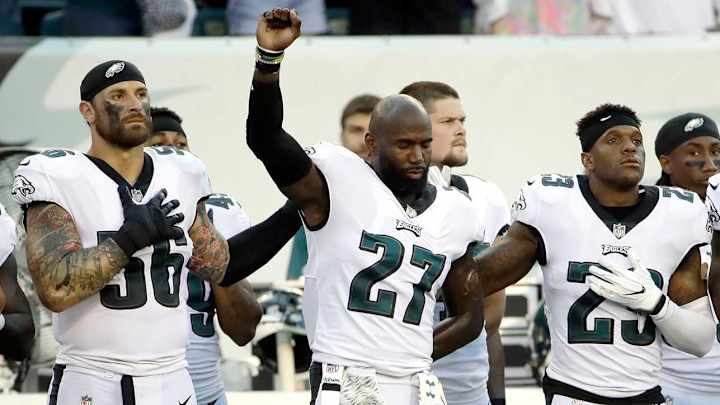
With reporting by Peter King in Jacksonville, Chris Burke in Detroit, Jenny Vrentas in East Rutherford, Robert Klemko in Denver, Bette Marston in Tampa and Michael McKnight in Los Angeles.
One late night a few weeks ago, Malcolm Jenkins was browsing the internet when he came upon a video report that Vice had produced about white supremacists marching on the University of Virginia campus, in Charlottesville. The video opens with a scene that’s now infamous: a group of white men marching in a line, carrying tiki torches, shouting, “You will not replace us!” Then, more specifically: “Jews will not replace us!”
“That was like the last thing I saw before I went to sleep,” Jenkins says. He only slept a few hours that night.
Soon thereafter, Jenkins sent a link of the video to the Eagles’ defensive backs group chat. It’s normal around the NFL for players to use group chats to discuss film, share notes or just joke with one another. Jenkins uses the his group chat as a forum to share articles about current events or update his teammates on the work he does in the community, as a way to help educate them and open their minds. After Colin Kaepernick started kneeling during the national anthem last season, to protest police brutality against African-Americans, Jenkins joined the protest by raising a fist during the anthem. Since then he’s been one of the more vocal players and one of the leaders in the activism movement spreading across the NFL.
After Jenkins sent the Vice video around, he noticed that his fellow safety, Rodney McLeod, who went to Virginia, started to participate more in his activism discussions. “I could sense that something was stirring in him,” Jenkins says. Then Chris Long, another former Virginia player, joined Jenkins’ demonstration. During Week 2 of the preseason Long stood next to Jenkins and put his arm around him during the anthem, as a way to symbolize that there were white players who were supporting their teammates during the protest, too.
What the Expanding Anthem Protests Mean
This week, as the anthem started, Jenkins took his usual spot on the sideline, near midfield, in front of a sprawling American flag, and raised his right fist. There was Long standing to his right, with his right hand over his heart and his left hand on Jenkins’ shoulder. Then to his left, there was McLeod, with a hand on his other shoulder. He had decided to join in the protest, too, unannounced.
“Once he saw what Chris did, once he saw a way to get involved and not do anything that was outside of himself, that opened the door,” Jenkins says. “That’s what a lot of people have been looking for. There are a lot of [players] who have strong opinions, and see the things on TV, see the things happening in our community, and may not necessarily want to take a knee. Or may not want to raise a fist.”

In the past year, the protest has come a long way from Kaepernick simply taking a knee. In Week 3 of the preseason, there were at least six games at which a player displayed a sign of protest of some kind during the anthem. In Dallas, Marshawn Lynch of the Raiders sat on a bench; in Seattle, the Seahawks’ Michael Bennett sat on a bench while Justin Britt, a white teammate, stood next to him with an arm on Bennet’s shoulder; in Baltimore, Cameron Jefferson of the Bills raised a close fist; in Nashville, three Titans players raised fists; and in Tampa, about 30 Browns players lined up and interlocked their arms. Marcus Peters of the Chiefs heard the national anthem in Seattle while sitting on a stationary bike; it wasn’t immediately clear if he was giving his legs a break or making a political statement.
After the Eagles game, McLeod was asked about his gesture. “I just felt like I needed to step up and do something,” he said. Then he decided to add an addendum to his answer. “I respect, you know, all the troops and veterans,” he said. “I have some in my family.” He listed them: his mother, his aunt, his grandfather, grandmother, great uncle… “I don’t want to draw attention away from [the flag],” McLeod said, “but I do want this country to all be one.”
How NAACP Leaders in NFL Cities View Colin Kaepernick and the Anthem Protests
McLeod surely has seen the backlash Kaepernick has endured from people who think he’s disrespecting the flag. It’s been one of the biggest stories of the offseason, how Kaepernick remains unsigned, and the suggestion that the NFL is blackballing him for kneeling. On the other end of the Eagles’ sideline, while Jenkins stood with his fist raised, Ron Brooks, a cornerback, another member of the group chat, knelt during the anthem, for the second week in a row. On Twitter, some fans immediately called for the Eagles to release him. Unlike Jenkins and Long, Brooks is on the fringe of the roster, fighting for a spot on the team. “Fans look at my protest and think it’s a more respectful way,” says Jenkins. “But I don’t see it any different. When Ron takes a knee, it’s no different than me raising fist.”
Maybe so. These protests can be interpreted any number of ways, which is why The MMQB sent reporters to seven games during Week 3 of the preseason, to take the pulse of football on this issue right now. We interviewed more 60 fans and a number of players about Kaepernick, why they think he is still unemployed, and what will happen next with this protest movement across the NFL. Two overarching points are clear: The players are still figuring out the best way to protest, and people have very strong opinions on both sides of this issue.
PHILADELPHIA, 5:20 p.m. Thursday
In the parking lot just northeast of Lincoln Financial Field, seven older men sit around in lawn chairs, laughing and joking and catching up with one another. They have cold beers in the cooler, burgers and bratwursts on the grill. These men, at one point, were some of the most powerful people in the Delaware state prison system. Over there is the former commissioner, and here are a few wardens and bureau chiefs. Retired now, in their 60s and 70s, they make a point to meet each year for a sporting event. They just watched their Phillies lose (again), but they’ve heard plenty about Kaepernick and his protest and, drawing from their line of work, they all seem to share a similar opinion.
Rodney Gibbons, the department’s former chief information officer, says Kaepernick is rightfully getting what he had coming to him, for protesting the way he did during the national anthem. “It got him the best press that he could get, O.K.? That was his intention, I suppose,” Gibbons says. “But now he has to pay the price for it. The American people don’t want that. They don’t want to see their national anthem disgraced. And that’s what he did.”
One of the group suggests that Kaepernick should have saved his political statement for Facebook. That perks up Stan Taylor, the former commissioner, who ran the department of corrections for 11 years. “I saw it as very selfish behavior,” Taylor says. “If he wants to make a statement, that’s fine, let him make the statement. But he’s trying to make the 49ers make the statement. That’s not his place to do. It’s selfish. It’s jeopardizing his teammates. It’s jeopardizing business. … If you’re the CEO of whatever team, you’re saying, can I afford to put stock in this guy when I don’t know what he’s going to do that may drive my stock down? It’s not about his freedom of speech. It’s about, he’s a danger to the corporation.”
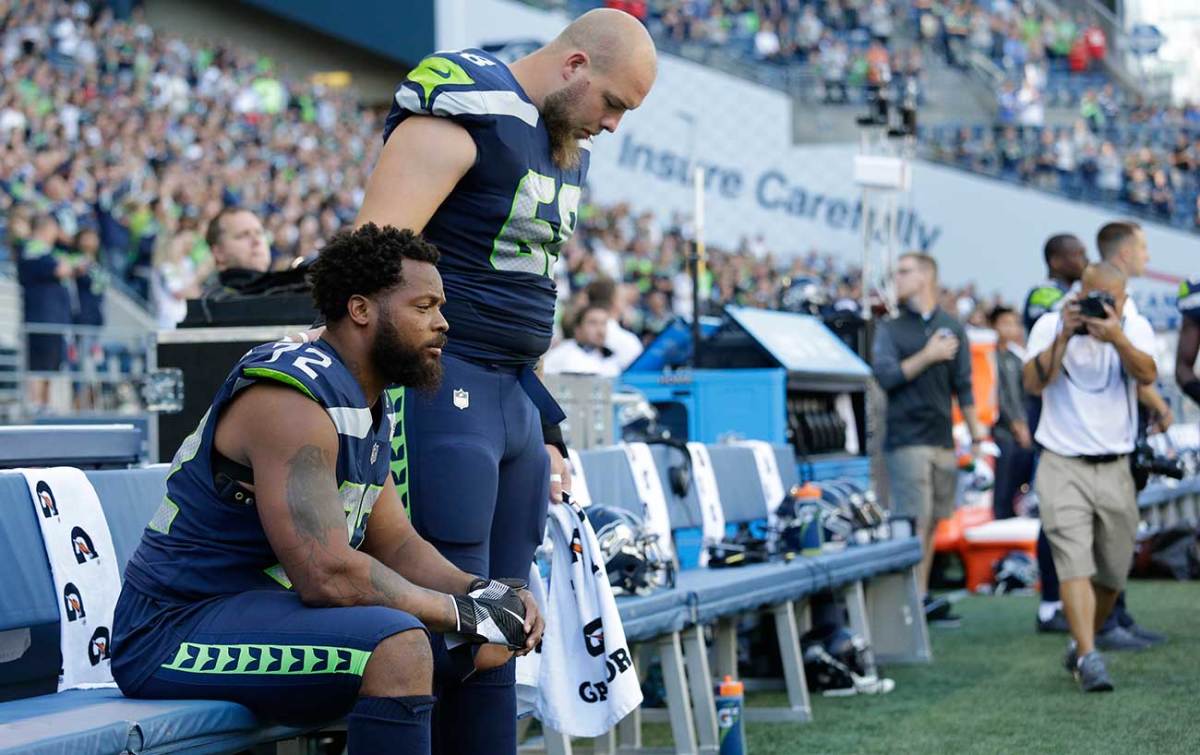
Mike Deloy, a former warden and bureau chief, sees a way out for Kaepernick. “If he just let it go, in time he would [play again],” Deloy says. “Anybody can make a mistake in this country and recover from it. I think he could, too.”
A few hundred feet away, Eric Zayas and his friends are pregaming out of the back of their SUV. They all grew up together in North Philly, in the same neighborhood, a group of Hispanic kids now in their 20s. Zayas is the outspoken one of the group. He works as a financial analyst at a Fortune 500 company, and he doesn’t think his company could get away with what he believes the NFL is doing to Kaepernick.
“If there’s discrimination in jobs for being a woman, for being anything else, why should a football team care if you care what’s going on in political settings?” Zayas says. “They shouldn’t care about that. He should be able to stand up for what he wants and not have to worry about not having a job tomorrow.
“If I go to work tomorrow and say something disrespectful about another gender, about another race, I get fired. But that’s not what he’s doing. He’s standing up for a cause, his own cause. He’s not disrespecting a religion, a race, nothing. He’s standing up for a cause of his own.
“He’s going to enact change, too. In 10 years this guy’s going to be in the history books. In 20, 30 years, this guy is going to be talked about in schools. Why not make a change now?”
JACKSONVILLE, 6:30 p.m. Thursday
It’s pouring rain, and in the distance there are the claps of thunder. About 45 minutes before kickoff, before the Jaguars play the Carolina Panthers, a group of fans has found shelter under the concourses of Everbank Field. One of them is Sam Long, a new season-ticket holder who wants the Jaguars to sign Kaepernick, for football reasons.
“I think this is all about the NFL sending a message to players—stay in your lane,” Long says. “I love the game. This is my first year with season tickets. This club they have here is just beautiful, and I wanted to be a part of it and have tickets for what I hope will be a turnaround. But we need a quarterback. There’s not many better than Kaepernick. Young, got a strong arm. He’s won before.
“I think he could really put people in the seats. Some people think the fans would be angry if he got signed—either here or wherever. You know how people are—if he won a couple of games, they’d be behind him. People would change their tune.”
The next day the Jaguars’ owner, Shad Khan, would say in a radio interview that is he “absolutely” O.K. if his front office wants to sign Kaepernick — making him the first owner to come out and speak publicly on the subject.
DETROIT, 4:30 p.m. Friday
In a surface lot across the street from Comerica Park, Matthew Cruz is prepping for the Patriots-Lions preseason game by drinking out of the back of his pickup truck and making friends with the people at neighboring tailgates. He’s adorned the bed of his truck with an American flag, and he’s blasting Toby Keith’s “Courtesy of the Red, White, and Blue.” When a friend calls looking for him, he stands and waves the flag as a way to signal his location. He has great respect for the flag, in part because he’s currently a sergeant in the U.S. Army.
This past year, whenever Cruz, 27, saw Kaepernick kneel during the national anthem, he says, he turned off the TV. “I may not be the biggest impact—like I’m just turning off my TV; they get millions of views—but I would never sit, I don’t care who you are,” Cruz says. “I’m actually stationed here. It hit us pretty hard. I do the military funeral honors for the state, so the flag, we plays “Taps” at all the veteran funerals. So when that stuff happens, it’s kind of like ‘Damn, I love football’ but dude, like, you’re playing a game. Football is not a worldwide sport, it’s an American sport.”
EAST RUTHERFORD, N.J., 6:50 p.m. Saturday
As the national anthem starts, the New York Giants stand in a straight line, shoulder to shoulder, all of them holding their helmets in their right hands. This is no accident. “We try to do it to look like a band of brothers,” says Jonathan Casillas, the veteran linebacker.
During training camp, for the second year in a row, Giants coach Ben McAdoo had Mike Sullivan, the offensive coordinator, give a presentation to the team about the national anthem. Sullivan is a former Army Ranger who played on and later coached the football team at West Point. “He put on a great presentation and just told us about how much it meant to him, how much it means to people in this country,” says Casillas. Then McAdoo told the team exactly how he wanted them to stand during the anthem, and they agreed to do it, as a team.
Sean McVay, in his first year as a head coach with the Rams, had a similar conversation with his players. “He was very upfront with us,” says Rodger Saffold, the Rams’ starting left guard. “He told us to stand on line with the national anthem, and if we have any disputes that we need to come to him and just let him know beforehand. I think that was extremely respectful of him. I think we just want to respect our team, respect our coach.”
Colin Kaepernick's Supporters Make Their Voices Heard Outside NFL’s Headquarters
In New York, Casillas had similar praise for McAdoo. “I think Ben does a great job showing empathy for things,” Casillas says. “There are a lot of things that are going on, a lot of racial tension, political tension, a lot of economic tension. There’s a lot of things going on in this country and in this world. But one thing we believe in and that we stand for, are the people that fought for us, and that’s what the flag represents to us.”
Casillas says he’s friends with Malcolm Jenkins; he has great respect for Jenkins’ protest. But in discussing the issue, he keeps returning to the concept of sticking together as a team. “[The coaches] basically said, that’s what we are going to do as a team,” Casillas says. “They didn’t say anything [like], you can’t do anything or you are going to do this or get reprimanded. … If there was something that would be happening, I would think we would discuss it, and it wouldn’t just be one person, because I don’t think we have that type of team.”
DENVER, 6 p.m. MST Saturday
Kickoff for Broncos-Packers is about an hour away, and Wayne Ortega, 65, is wheeling his friend, a disabled veteran, to a tailgate. Ortega has been coming to Broncos games since 1968, when he was a little leaguer and his team cleaned the stadium in exchange for free admission. He’s seen it all, from the Orange Crush to John Elway to Peyton Manning. He thinks that the Broncos would’ve signed Kaepernick, too, if not for his anthem protest.
“Players should not be punished for voicing their opinions,” Ortega says. “The owners have this plantation mentality.” He saw last year how the telecom company CenturyLink ended an endorsement deal with Broncos linebacker Brandon Marshall after he knelt during the anthem. “When CenturyLink calls me, I say I would never do business with a company that dropped a player just for expressing beliefs. This is still America, and it’s not 1950s America.”
LOS ANGELES, 5:15 p.m. PST Saturday
It’s another beautiful day in L.A., and a group of four white women in their 20s snap Instagram photos outside the Coliseum’s gates before heading in to the Rams-Chargers game. They’ve heard a lot about Kaepernick kneeling during the national anthem. One of them, a woman named Michelle McDonald, who’s 27 and works in finance, says that Kaepernick doesn’t have a job now because “he doesn’t like his country and he has a poor attitude.”
When a reporter asks more about the protests, the girls admit they don’t know what exactly Kaepernick is protesting. They’re told he originally protested police brutality against people of color. “I forgot that was why he was protesting,” says Lindsey Bunker, a 26-year-old who works in sales. “It got publicized so much that he didn’t respect his country that it took away from the actual [purpose of his protest]. I didn’t even know why he was doing that. I just thought he didn’t like America anymore. You should be able to stand up for what you believe in, because that’s what our country is all about. But you need to do it in a way that conveys you actual point.”
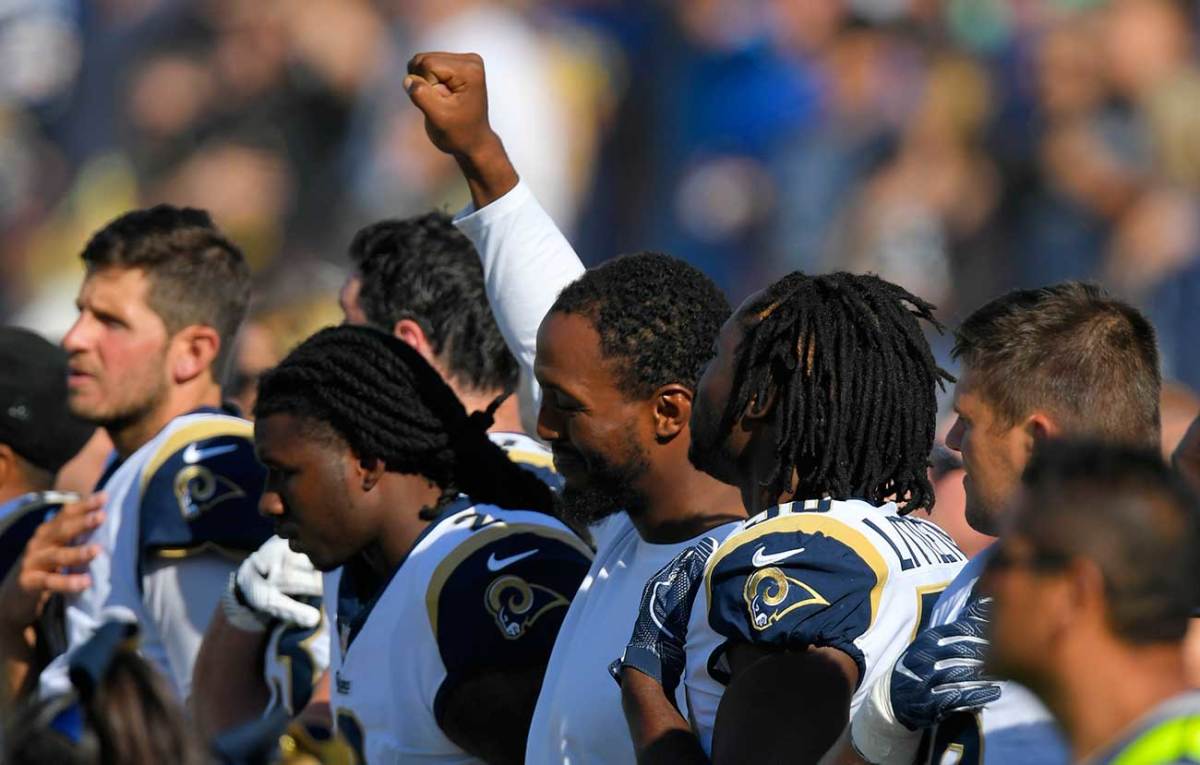
Also walking into the Coliseum around this time is Jeff Thierry, a retired engineer, who’s taking his granddaughter to the game. He is a 60-year-old black man, with a neatly trimmed white goatee. He is well aware of why Kaepernick is kneeling. “The citizens of this country have a very passionate opinion about the United States flag,” Thierry says. “There’s a misunderstanding between that and what Colin Kaepernick is doing. It’s not clear. His stance is not about the flag. It’s about unarmed African-American people and people of color being subjected to violence by police and [the police] not being held accountable for that.”
TAMPA, 11:20 p.m. Saturday
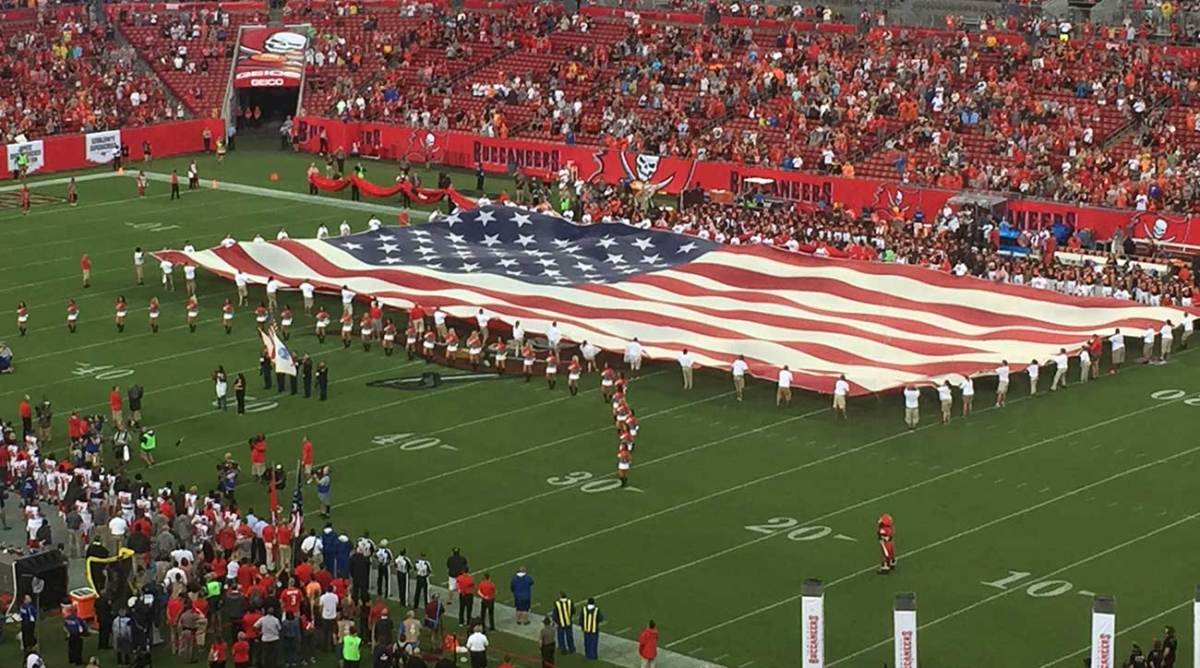
The Cleveland Browns’ locker room is opened to the media, and reporters gather around the expected players: DeShone Kizer, Duke Johnson, Corey Coleman. Seth DeValve, getting dressed in a blue suit, is mostly left to himself. Previously a little-known second-year tight end from Princeton, he became famous around the NFL a week earlier as the first white player to kneel during the national anthem. He and 11 other Browns knelt in silent prayer in a circle on the sideline, while a few other teammates, including Kizer, the rookie quarterback, stood next to the group with their hands placed on their shoulders.
DeValve was walking the same line that Chris Long was in Philadelphia, wanting to join in the protest and support his African-American teammates, without drawing attention away from the reason for the demonstration. Before putting his hand on Jenkins’ shoulder, Long made sure to ask Jenkins if he thought it was a good idea. DeValve had his own sounding board at home: his wife, Erica, who is black. After DeValve knelt last week, his wife penned an essay for The Root in which she praised him for kneeling but urged people to focus on what he was kneeling for, rather than the fact that a white player got involved. “We should not see Seth’s participation as legitimizing this movement,” she wrote. “Rather, he chose to be an ally of his black teammates.” Focusing on Seth, she wrote, distracts “from what our real focus should be: listening to the experiences and the voices” of the black players protesting.
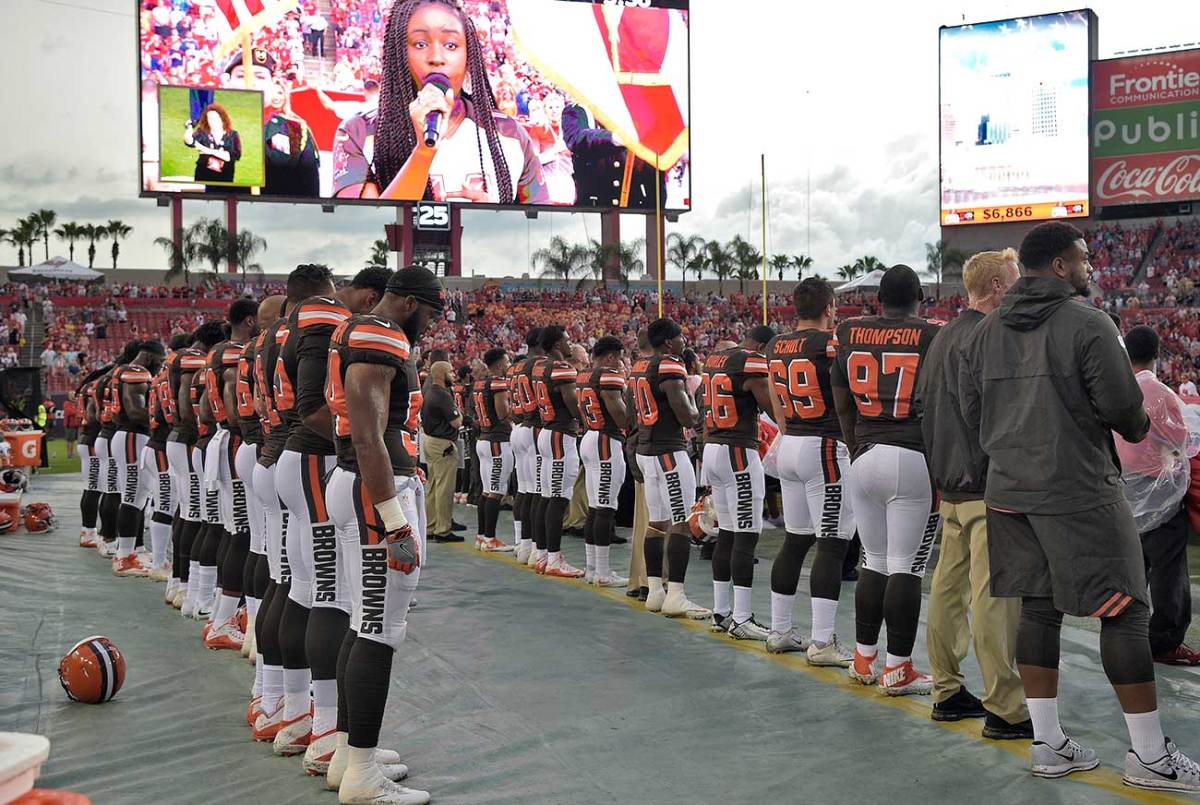
“She’s extremely knowledgeable about this country’s history, about her race,” DeValve says in the Browns’ locker room. “She studies this. … She studied it at school. She’s studied it her whole life. She is kind of my library, so to speak, where I can get my facts straight.”
The Browns had another influential voice in their ear this week, too: Hall of Famer and longtime civil rights activist Jim Brown. In an interview with The PostGame, Brown said he wouldn’t “desecrate my flag and my national anthem” the way he felt Kaepernick had by kneeling. Brown also spoke to the team and gave his opinion as to how they should protest. “Jim Brown’s message to us was really that it’s important to be unified as a team and as an organization because that’s really where you make a difference, and that’s where your voice becomes very powerful,” DeValve says. “So that’s kind of the goal right now.”
Colin Kaepernick Can Be an Activist AND a Football Player
This week, the Browns didn’t kneel. Instead, about 30 of them, DeValve included, stood side-by-side with their arms interlocked during the anthem. They chose not to kneel, DeValve says, because they’re “working on defining what exactly the points are that we want to get across, and then agreeing upon them as a team and doing it all together as a team.”
PHILADELPHIA, 11 p.m. Thursday
The Eagles locker room is cleared out. Long, McLeod, Brooks and the others have gone home for the night. Jenkins has already done at least three media sessions, and he’s still talking to a reporter about the protests going around the NFL, about this moment in time. The players have the country’s attention, they have a stage, he says, “and now it’s time to use it.”
This offseason, Jenkins, Anquan Boldin and a few other players formed a coalition to help organize the protests and put some of what they’re saying into action. Over the summer they went to Capitol Hill and lobbied for criminal justice reform. They pushed for specific legislation in Ohio, Pennsylvania and Louisiana. As they add more members, they plan to expand their reach. As of now, Jenkins says, the coalition is up to about 40 players.
Every NFL Player Who Has Protested During the National Anthem This Season
In the coming weeks they’re going to be increasingly vocal, Jenkins says. They’re going to write op-eds, reach out to more politicians and speak up about specific issues in their communities. In Pennsylvania, for instance, Jenkins wants to throw support behind a bill that would give people convicted of minor offenses the chance to seal their records after a certain period of time, which would help them get jobs—and he also wants to oppose a piece of legislation that’s being discussed that would reintroduce minimum mandatory prison sentences.
This movement that Kaepernick started has grown to encompass many other issues beyond police brutality. “It’s about people dying at the hands of police officers when they don’t need to. It’s about mass incarceration and the effects that it has on communities of color, on poor communities. It’s about the divide in quality of education in communities. The financial gap. All of these things kind of coincide,” Jenkins says. These are the things that are being discussed in locker rooms more now; this is why more players are joining in and kneeling or sitting or raising a fist. “We’re seeing an awakening [around the NFL], a realization that you can make things happen,” Jenkins says. “Guys are learning, working their way through this. We’re football players; we’re not activists, so we’re learning as we go.”
Question or comment? Email us at talkback@themmqb.com.
